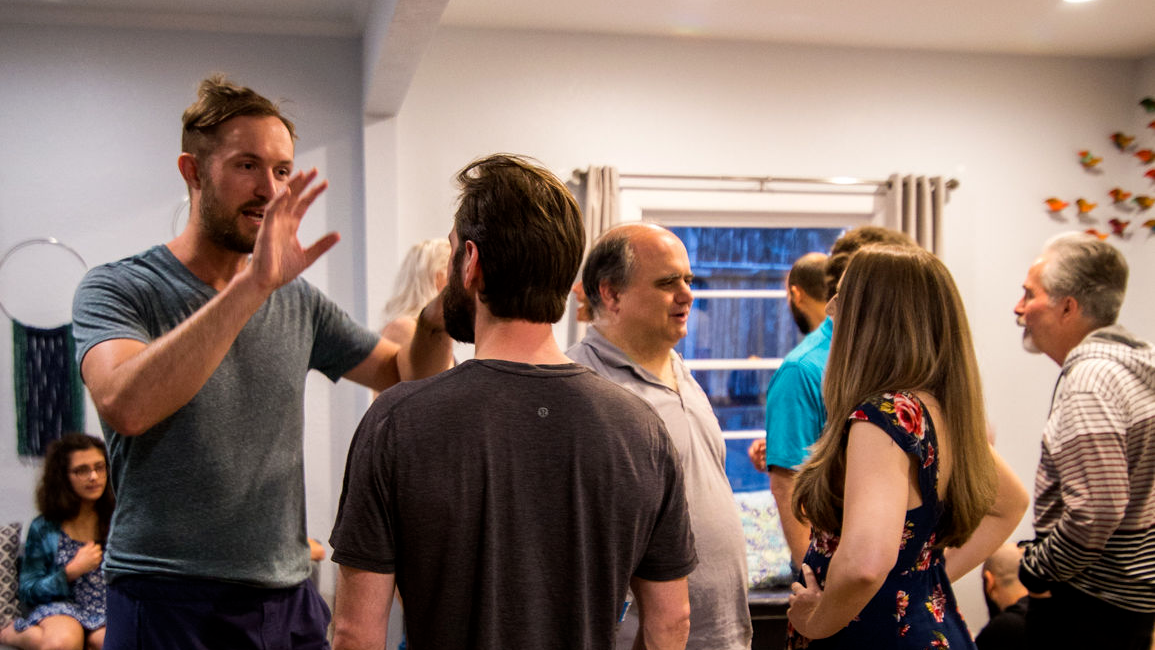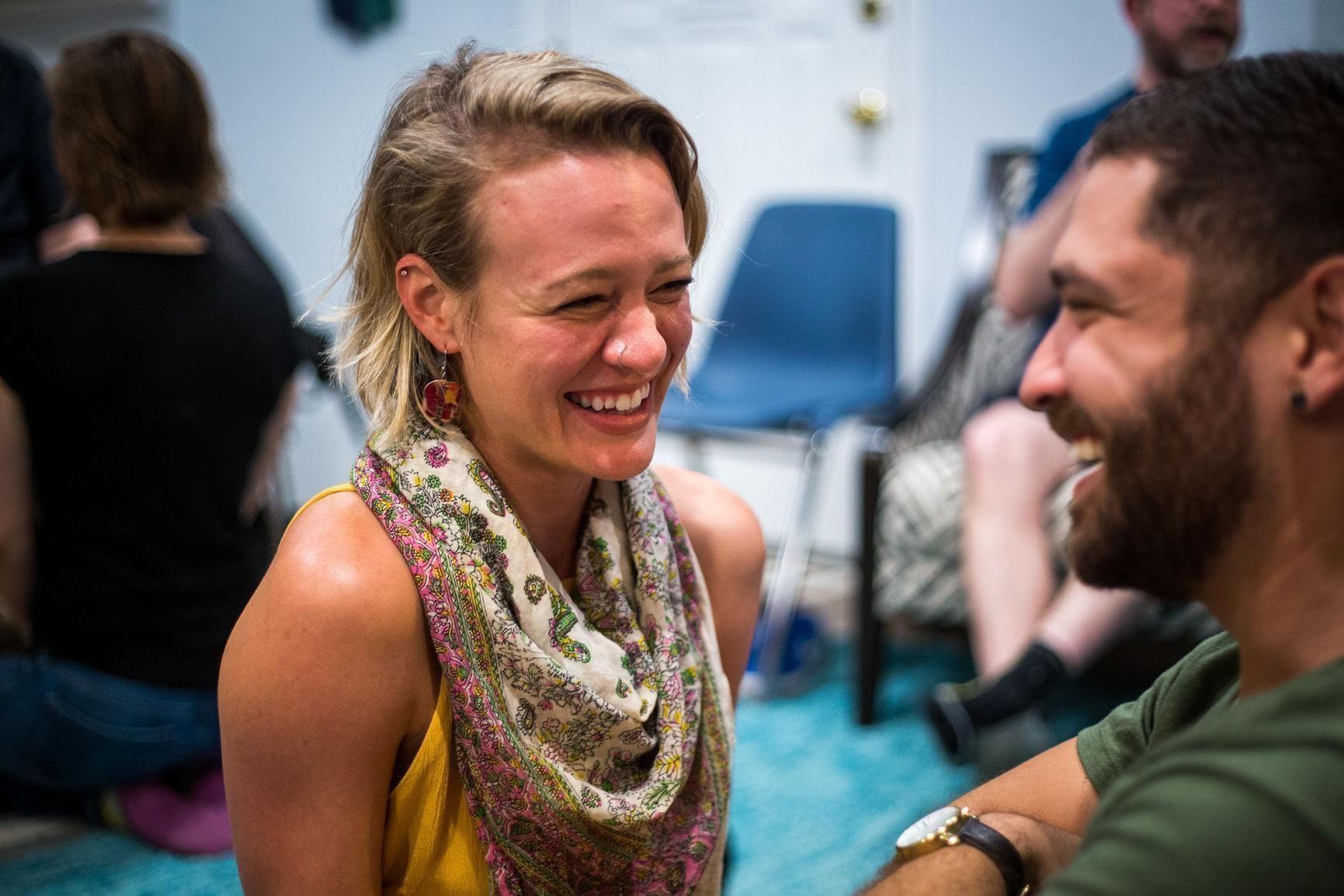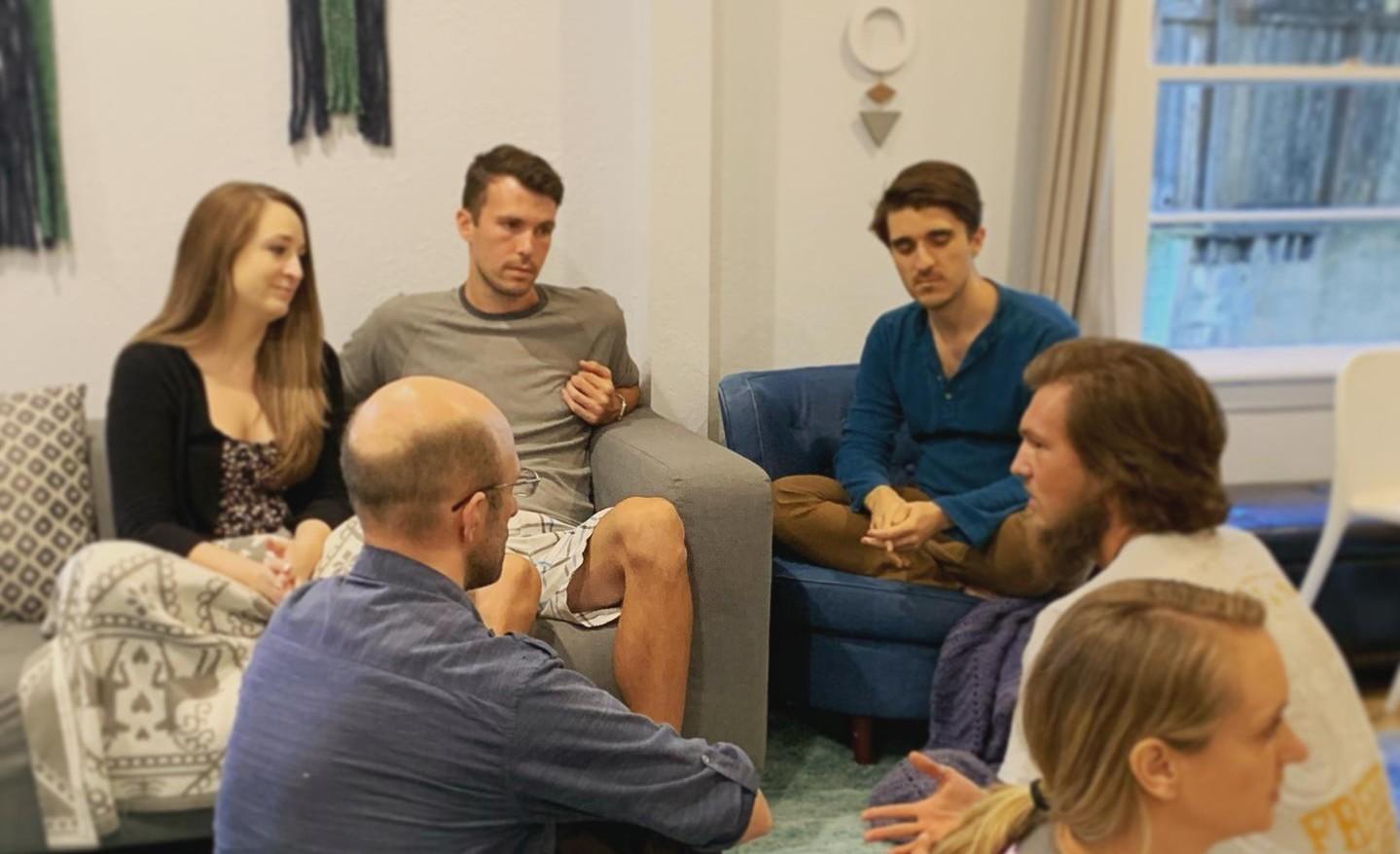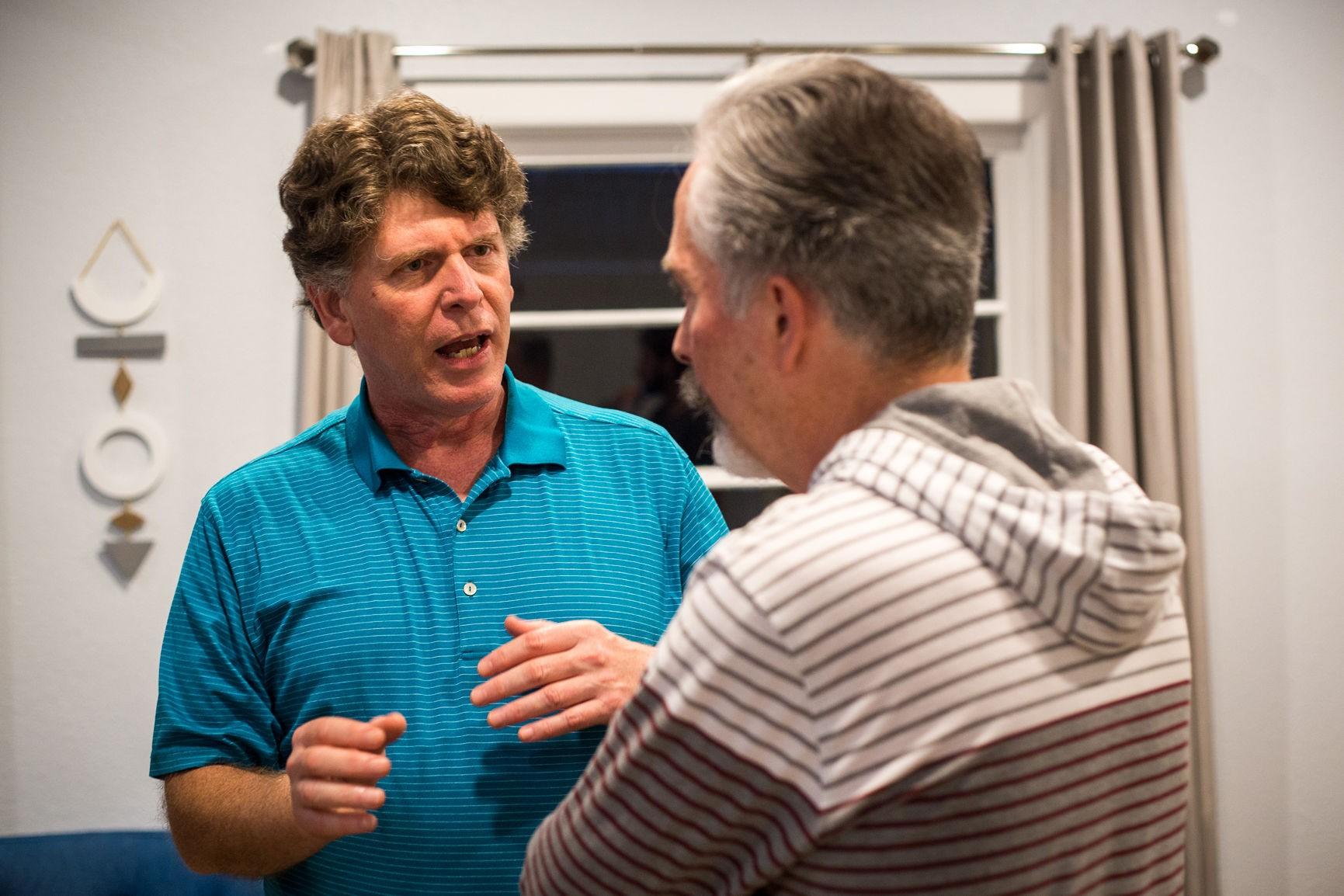What happens in Relatefulness, in a descriptive sense?

— The Feeling & the People —
Imagine you’ve decided to show up for a “Relatefulness night” in Anytown, Earth. Walking into a large room in a rented house you notice two comfy looking couches and a couple of colorful rugs, and the tables are dotted with succulents and flowers. The space has a casual vibe, somewhat like a cross between a yoga studio and a living room; well-cared for and well-used.
A gentleman in his late forties with curly salt & pepper hair greets you with a smile and asks if you’ve signed in. Behind him about a dozen other people are milling about, engaged in what appears to range from casual to meaningful conversation. One hippie-looking couple are staring into each other’s eyes without saying a word (awkward, you think to yourself), but almost everyone else seems pretty normal.
After reviewing a document on participant responsibility, expectations of leadership, and a little clarification on what this practice is and isn’t, you walk over to a group of people and ask what they do for a living. The thirty-something woman does marketing, the forty-something dude is a software engineer at a local startup, the kid you would have guessed is an undergrad is actually a massage therapist, and the pretty woman in her early sixties does HR for a local non-profit.
Somehow this small group seem to be speaking normally… and yet they occasionally ask questions that take the conversation in a direction you wouldn’t have predicted. Instead of asking you more about where you’re from, they ask you what it’s like to be here. Occasionally they share what they’re feeling, the software engineer even referencing a sensation in his stomach in response to something you say. When you note how this is a little unusual and ask about it, the HR woman tells you, “That’s being Relateful, you’re a natural”. You have no idea what she’s talking about.
Before you have a chance to ask more, a Person-Who-Exudes-Authority (presumably the evening’s facilitator) quietly says, “If you can hear my voice, please enter your deepest meditation”, with a mischievous grin. The room enters into a pregnant silence with surprising quickness.
The facilitator continues, “Start to notice where your attention is already going”. She then begins to discuss two types of practices that will be facilitated at this event...

— Relateful Focus —
(similar to a "Focus circle", or a "Birthday circle")
The Setup:
In an average session, 3-10 people sit in a circle and focus their attention on one person for a set amount of time, typically 20 - 45 minutes.
The Action:
The session begins by selecting the Focusee (the person who will be the focus of attention). This is followed by a brief (under a minute) guided meditation, and then moves to a more open exploratory period of communication and interaction. During this phase anyone in the group can simultaneously:
- Ask questions to try to get a feel for what the focusee’s present moment experience is really like for them (rather than intellectual understanding).
- Speak their personal, in-the-moment experience of being with the focusee.
This activity of (1) getting a feel for the focusee’s present moment experience, and (2) speaking one’s in-the-moment experience of being with the focusee is 95% of the activity that occurs during Relateful Focus.
The Finish:
Near the end, the facilitator brings attention to the fact that the session will finish in a few minutes, and looks for a simple way to officially bring the group to a closure (such as hearing one word from each participant).
— Relateful Flow —
(similar to a "Flow circle", "Surrendered leadership", or "Organic circling")
The Setup:
Relateful Flow partcipant numbers have ranged from just 3 people, to upwards of 100, and a session can last from 30 minutes to 5 hours. When space permits, all of the people face each other in a roughly circular shape (or in online video-conferencing software). Otherwise there tend to be two or three “rows” like stadium seating, with one row on chairs in the back and one row on the floor in front.
The Action:
Regardless of the size or perception, the session typically begins with the facilitator acknowledging in some way that the session has started. While this generally happens in spoken communication, such as “If you haven’t already begun practicing, I invite you to begin now”, different facilitators may use their own creative expression to signal the session opening. This can include a particularly communicative silence.
The facilitator will often say a sentence or two that sets the tone, and acts as context for the session. This is a personal and creative expression so it looks different almost every time. But it almost always references an in-the-moment experience while inviting participants to:
- Take responsibility for leading themselves.
- Be in contact with the group.
- Listen for an intuition that guides them to something larger than themselves.
For example, an author was once chatting about Teenage Mutant Ninja Turtles with participants before the event started, so he set the context by saying; “For the next ninety minutes, I invite us to meditate in the style of Ninja Turtles. This means on the one hand we welcome each of our unique contributions for making this Flow our own—like the moodiness of Raphael, the goofiness of Michelangelo, the leaderliness of Leonardo, or the intelligence of Donatello. And we act as a team to make the city a better place—in other words, challenging and supporting each other while being guided toward a good that is beyond our personal gain”.
Although first time participants may fail to recognize these clues, they tend to report in retrospect that the opening statements indeed generated a starter seed and guidance for the session's activity.
During the rest of the time, people interact in a variety of ways, including speaking plainly, physically moving (which can involve consensual interactions with other participants, such as a hug), sharing meta-observations, and integrating other forms of meditation and personal practices.
The facilitator(s) partakes in all the actions listed in the previous paragraph, while taking on an additional role of guiding individual and group interactions to more “presence” and “surrender”. They also draw boundaries around the kinds of participation that move away from these, such as attempting to force everyone in the session into one particular healing-oriented activity.
Exploring Themes:
Participants often notice Relateful Flow sessions revolving around a universal theme that is shared by members of the group, yet also experienced in very unique ways by each individual. For example, consider a session where a man is experiencing the grief of losing a loved one. Meanwhile another man expresses anger for the first time, a woman experiences blankness, and another woman notices she feels disgusted. At first, these all seem unrelated, but upon reflection the individuals realize they’re revealing their responses to death and grief—anger at being powerless, blankness to the depth of grief, and disgust in avoidance of facing the pain of loss.
These kinds of shared-but-unique themes are so common that many practitioners believe this is a feature of all Flow sessions, whether or not the themes are noticed or spoken. Common perspectives for understanding this phenomenon include Family Constellations, Gestalt, Psychodrama, and Internal Family Systems (especially when applied to each member of the session at once). These are all welcome perspectives, but Relateful Flow as a practice does not affiliate with any one of them.
Any given Relateful Flow session may revolve around one theme, explore sub-themes, move through a few in a kind of sequence, or evolve in thematic complexity as the session progresses. Groups generally reject any individual attempting to assert a particular theme or model’s validity or universality unless it acknowledges the unique interpretations of the individuals.
Spontaneous Rituals:
Occasionally certain kinds of “rituals” will naturally emerge as a product of the individuals all opting into a particular process, knowing they can question it or step out of it at any time. These are usually highly idiosyncratic, such as one group member pulling an imaginary light-switch to signal a group action. While rituals from other practices may be the initial spark of an idea, the results are creative to the point of unpredictability.
Things Getting "Kind of Weird":
Participants commonly report perceptual shifts similar to mystical and druglike experiences, such as seeing facial distortions that look like other people (often from different time periods), the room brightening in whitish-yellow light, increases in the vibrancy of sensory detail (especially visual, auditory, and somatic), a feeling of being in touch with a particular archetype such as “the jester”, “the cat”, or “the mother”, entering “timeless” and “boundless” experiences of empty presence, expanded or liberated senses of self-identity, unitive experiences with other participants, the group, and/or all of life.
It’s also fairly common to see people shaking—anything from a quick little shiver up the spine, to a kind of consistent shaking of the arm or leg for instance. Whether one considers these neurogenic tremors, energy release, or something more esoteric like Kundalini or ecstatic movement a la Shakers, the experience is consistently reported to be neutral or pleasant.
These phenomena can coexist to a surprising degree with more familiar experiences.
The Finish:
A Relateful Flow session can end in a variety of meaningfully different ways. Nevertheless we can observe some patterns:
Although anyone in the session can “call the end”, if they do so without attunement to the current state of the group, the group fails to follow their direction and continues with the Relateful Flow. As a result the facilitator often looks for a shift in the energy to signal a change in context.
If there is a strong time-limit, such as a Relatefulness night, coaching session, or online session, the facilitator will typically look for ways to speak this reality to the group a few minutes before the end. Making the pending end-of-time common knowledge in the group usually helps bring about a sense of closing, while acknowledging that people will continue to be impacted by the session's events even after the official end.
Occasionally the facilitator will lead a more directed closing ritual, such as breaking people into pairs to go back and forth finishing the stem of a sentence that can help generate insight and meaning from the session. These “sentence stems” usually reference themes surfaced during the practice, including but not limited to specific occurrences, interpretations, and people from the session.

— Special types of Relateful Flow —
Flow with 35+ People:
Relateful Flow sessions that are larger than 35 people, or longer than two hours have a unique flavor. For one thing the whole group's attention doesn't stay together as much—you might spontaneously end up with two or more conversations happening in parallel, or even see the group reorganize into smaller groups as people change seats according to their intuitions about where to be.
These smaller ‘breakout groups’ will change size, shape, and position throughout the allotted time as individual members move fluidly between groups at any given moment, choosing on their own discretion. These breakouts often recollect into the larger -whole group dynamic- at the end of the time.
“Whole Group” Relateful Flow sessions:
There's a phenomenon where people will sometimes complain that a Relateful Flow group feels 'too big'. One interesting thing about this is that this reaction comes up when the attendees of a given event are being Relateful all together, whether or not that's actually a big number.
For example, if the event has 10 participants, one of these 10 will often report “feeling like” the -whole group dynamic- is “too big” compared to smaller breakout groups. Yet put roughly the same group of people in a breakout group of 13 people at an event with 34 total participants, and the same person will report “feeling like” this is a workable size.

— Every relateful session is wildly unique —
(Thanks to Pete Michaud for this analogy)
Imagine that you’ve never watched a movie before. No matter how well it is described, you will likely have a difficult time understanding what a movie actually is without experiencing it first hand. Relatefulness is very similar.
Now imagine that you have just watched a movie for the first time. You will now have a pretty solid idea of what a movie is—almost all movies have moving images, music, dialogue, plots, and so forth. Almost all Relateful sessions have such similarities.
At the same time, you’d be hard pressed to really understand a horror movie or a documentary if what you just saw was an animated Disney movie. You would likely find your predictions about the larger category of movies even less accurate.
Relateful Focus and Flow are analogous in this regard, in that each experience is very unique. Even sessions with the very same people vary each time they get together; in genre, pacing, themes, and more. And just like movies have changed dramatically since their inception, Relatefulness continues to evolve.
As a result, we encourage you to try a couple of sessions to get a real sense of what’s going on, even at a nuts and bolts level.

